Road skills
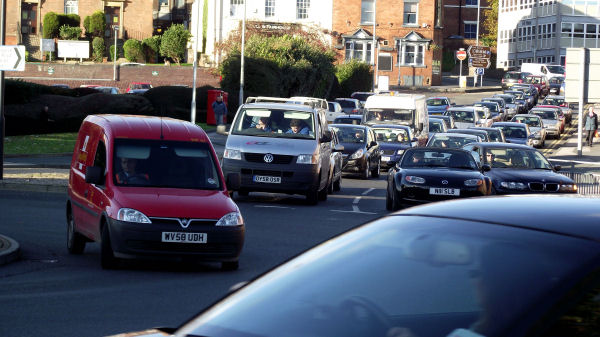
This page contains information designed to get you thinking about road procedure - following some basic procedures is a good basis for developing 'disciplined' driving.
Read the notes below - after reading the notes watch the video in Step 4 again.
Road procedure is partly about rules and regulations, partly about decision making and partly about attitude - this mix goes together to produce a flexible 'thinking' approach to driving.
A good driver knows what to do, when to do it and perhaps most important of all, when not to do it. Accidents happen when people make wrong choices, wrong decisions - making sure you fully understand the basics will help you to make the right driving decisions,
Visual scanning
A proper visual scanning technique is essential for safe driving - more especially so if you like to drive quickly.
This will include the correct sequence of observation before moving off and stopping, use of the MSM (Mirrors Signal Manoeuvre) routine, and taking effective observation before emerging at all junctions.
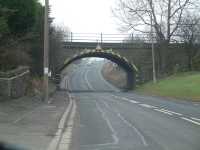 The ability to safely maximise sight lines and zones of vision is also essential. For example, in the situation shown in the picture, would you naturally be thinking about positioning to gain maximum view ahead in order to consider how the bridge may affect approaching vehicles?
The ability to safely maximise sight lines and zones of vision is also essential. For example, in the situation shown in the picture, would you naturally be thinking about positioning to gain maximum view ahead in order to consider how the bridge may affect approaching vehicles?
You will need to develop a visual scanning technique while both driving normally and carrying out the set manoeuvres required for ADI part-Two.
By developing a good scanning technique you will ensure that adequate safety margins are maintained at all times; you will also maximise your economy through better use of the accelerator, brakes and gears. The exercises set out in this course you will help you to maximise your 'driving vision'.
Dealing with hazards
 As an experienced driver you will be aware of many dangers, or hazards, on the road. But not all problems are as obvious as the sheep shown here.
As an experienced driver you will be aware of many dangers, or hazards, on the road. But not all problems are as obvious as the sheep shown here.
An expert driver is able to distinguish between high and low priority hazards, i.e., those posing an imminent threat, and those not requiring immediate action.
As your skills develop you will learn to 'read the road' in such a way that any action necessary to cope with any hazard can be taken in good time without stress or danger.
As you will learn later, reading the road means much, much more than simply watching the car in front! You need to become a bit of a 'driving detective'...
You will soon be looking for clues, solving problems and preventing murders (At least helping to prevent deaths on the road!).
A system of vehicle control
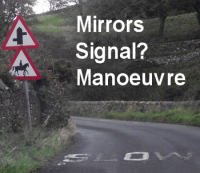 Different bodies (Police, Government, etc. advanced driving organisations, etc.) suggest different approaches to driving, but they all have one thing in common - they all suggest that you use a routine approach to hazards.
Different bodies (Police, Government, etc. advanced driving organisations, etc.) suggest different approaches to driving, but they all have one thing in common - they all suggest that you use a routine approach to hazards.
The use of a good system of vehicle control is essential if you are to cope safely with the hazards that you encounter.
The UK Highway code suggests the system of Mirrors, Signal, Manoeuvre (MSM). This is expanded by the Driver and Vehicle Standards Agency into a more comprehensive system (explained later).
Many advanced driving organisations prefer the 'System of Car Control' used by UK police forces – in reality, it doesn't matter a great deal which method you use, as long as you start to adopt a 'systematic approach' to your driving.
Learning about a particular routine is not enough in itself! You must use it early, in full or in part for any situation that requires a change of speed or position or direction.
Driving to a system will ensure that you are always in the right place on the road, travelling at an appropriate speed, knowing what is happening around you - and others will be aware of your intentions via any signals that you might give. Later in the course you will learn how, when and why to use a good system of vehicle control.
Hazard identification
Development of commentary driving (covered in this programme) will help with the identification and assessment of hazards and might be required if you do an advanced test.
Commentary is simply 'thinking out loud'. All the time you are behind the wheel your brain is actively processing information received through the senses. Your eyes, ears, fingertips, the seat of your pants and even your sense of smell provide the information for your driving decisions.
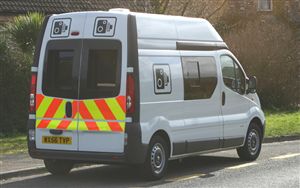 Your commentary will translate this mental process into words.
Your commentary will translate this mental process into words.
The police camera van is not a hazard... But it could become one if you don't see it!
You also need to consider how its presence will effect other drivers. Will they brake late? Will they be unduly cautious? How might these things affect you?
This is an example of how you will be thinking as you develop your commentary driving and hazard recognition skills.
In short, commentary driving is all about perceiving and dealing with hazards. Younger drivers in the UK will be familiar with the concept of 'hazard perception' because they have passed having passed a Hazard Perception Test as part of the driving test process (you may already have passed this test as part of your ADI qualification). As an experienced driver you will have gained some natural hazard perception skills – this guide will help to hone and develop these skills. Expert hazard perception requires good visual scanning, excellent acceleration sense and an ability to predict the future!
Positioning
A good driver is in the correct road position at all times, with regard to both safety and legal considerations. If you find that other drivers 'honk the horn' at you a lot, it could be because your positioning leaves something to be desired!
Good road positioning will depend on good observation of signs and road markings and a general all around awareness of the road and traffic situation.
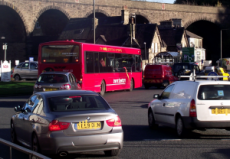 Along with all of the skills discussed so far, adopting correct position on the road is essential for safe driving. You must ensure that you are aware of the:
Along with all of the skills discussed so far, adopting correct position on the road is essential for safe driving. You must ensure that you are aware of the:
- Need to maintain sight lines for optimum forward vision
- Most suitable position to adopt when approaching hazards
- Way in which your road position can affect other road users
Specifically you will need to position correctly for:
- Safe parking and other slow manoeuvres
- Meeting other traffic
- Approaching junctions (including roundabouts)
- One way systems
 Lane discipline
Lane discipline
You must be in the correct lane for any intended manoeuvre.
This will be particularly important in one-way systems, on motorways and other multi-lane roads and at junctions with filter systems in operation. Correct positioning in your lane is also important.
While 'road positioning' refers to your position in relation to the kerb or any road markings, it's no good being well positioned in a lane when you are in the wrong lane!
Correct positioning will save wasted time and wasted fuel as a result of taking wrong turnings.
Speed and distance
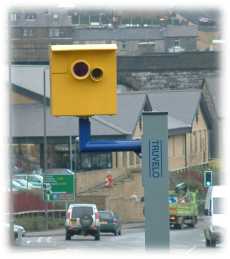 Many accidents are caused because drivers do not have enough time to react safely when they encounter a hazard situation and are therefore unable to stop within the clear distance ahead of their vehicles.
Many accidents are caused because drivers do not have enough time to react safely when they encounter a hazard situation and are therefore unable to stop within the clear distance ahead of their vehicles.
Comments like "he came out of nowhere" or "it all happened so fast there was nothing I could do" – have no place in better driving! If you are travelling at a safe speed you will have time to react and act.
Good drivers recognise the need for a safe speed in all normal driving situations, regardless of the speed limit, and the importance of keeping proper safety margins at all times.
Failing to drive at an appropriate speed and maintain a safe distance is perhaps the most expensive mistake a driver can make. In this guide we talk about driving economy through better driving - bad driving causes crashes. Crashes cost money, cost lives and have a heavy environmental price.
You must never drive so fast that you are unable to stop well within the distance that you can see to be clear ahead. Road surface and weather conditions must be taken into account when determining a safe speed. It's no use blaming the rain or whatever - like you hadn't noticed it was raining!
Making progress by driving at a speed that fits with road and traffic conditions is as important as being able to stop. Good drivers don't 'get in the way' - they know how to drive briskly, getting up to speed limits where safe and appropriate.
A good driver will recognise the opportunities to safely drive at the maximum permitted speed for any given road. You must also avoid hesitancy, i.e., you must be able to take all safe opportunities to proceed.
(Note: This is not a 'drive as fast as you can' course, however, the ability to flow with traffic is essential for safe driving).
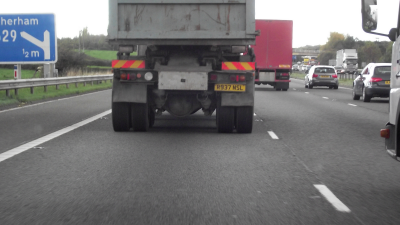 Judging distance
Judging distance
It is of the utmost importance that you have a sound judgment of distance in all driving situations.
You must be able to evaluate the speed and distance of other vehicles when overtaking, meeting or crossing the path of other vehicles and emerging at junctions.
You must also be able to maintain a safe distance when following other vehicles, keeping in mind road surface and weather conditions and the position and speed of any vehicle that is following you.
What about the following distance shown in this photo - is this what you normally see when travelling at 40mph or more? If so you will benefit from learning, or refreshing your knowledge about the 'two-second-rule' discussed later in i-Course Driving and on the SmartDriving.co.uk web site.
Next: Watch the video in Step 4 again and then move on to Step 6 to complete your learning checklist for this unit.